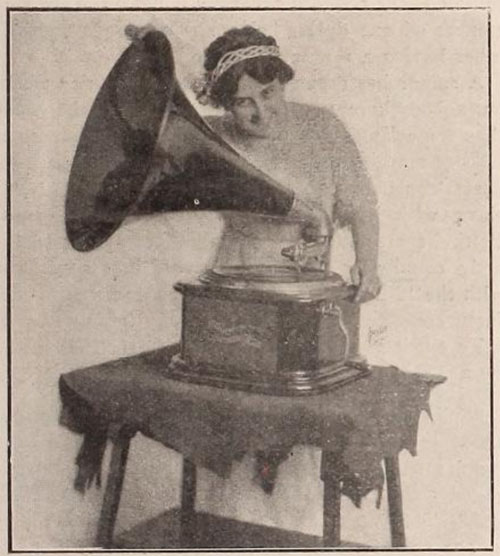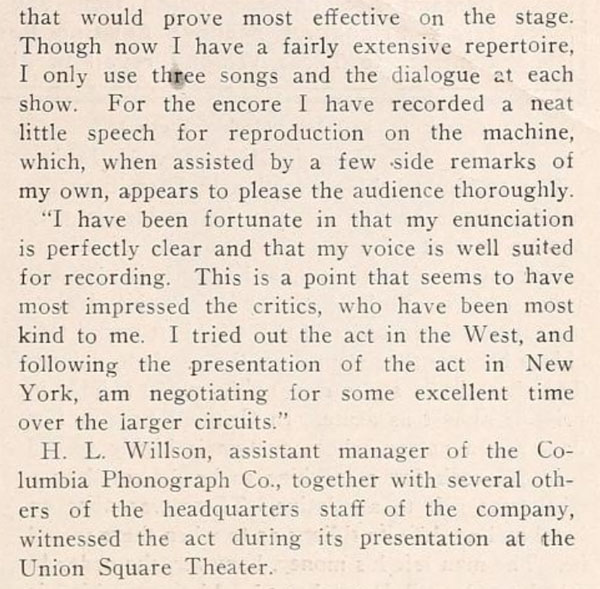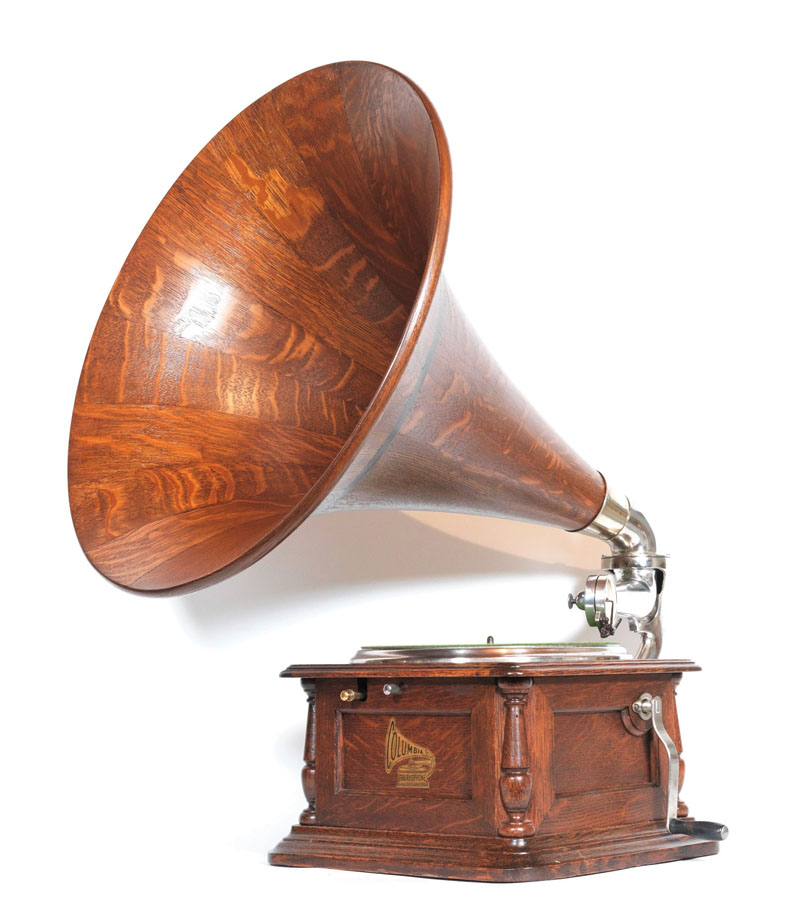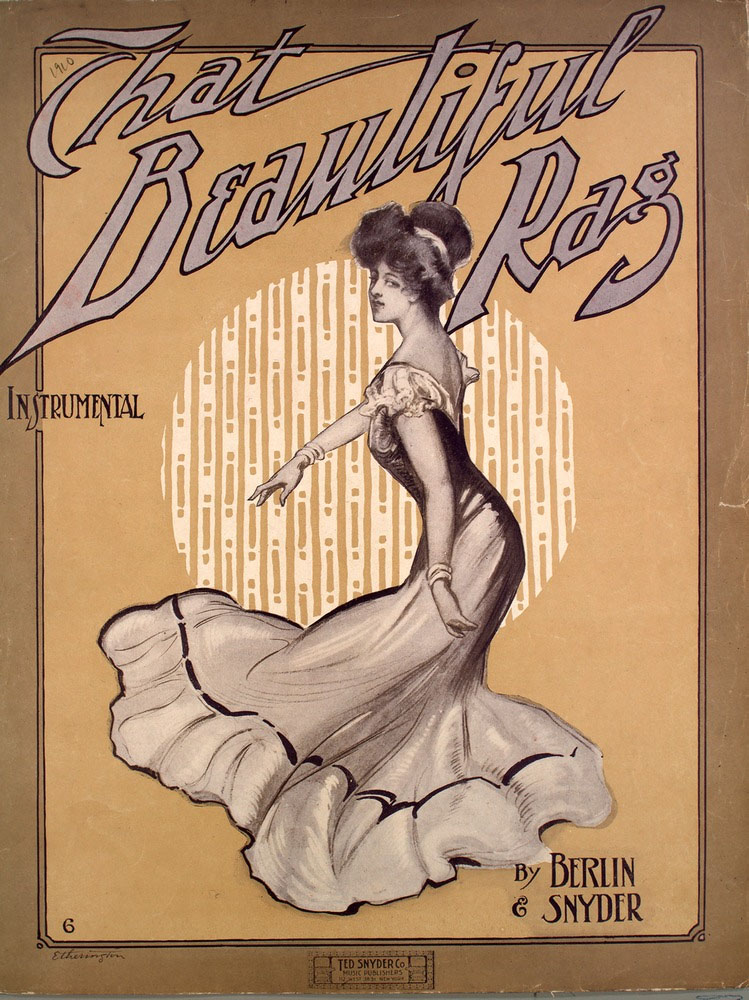|
Vaudeville and the Phonograph

"The
Graphophone Girl"
By Doug Boilesen, June 2024
Vaudeville entertainment in North America
from the 1880's into the 1930's saw a variety of acts, often unrelated
performances, grouped together under one bill. Wikipedia
identifies types of acts to have included "popular and classical
musicians, singers, dancers, comedians, trained animals, magicians,
ventriloquists, strongmen, female and male impersonators, acrobats,
clowns, illustrated songs, jugglers, one-act plays or scenes from
plays, athletes, lecturing celebrities, minstrels, and films."
In 1912 "Miss Adelaide Francis,
a clever singing comedienne," created a "Sister" act
with "musical numbers and humorous dialogue" performed by
Miss Francis interacting with a voice from a Columbia graphophone.
The act was billed as "The Graphophone Girl."
Miss Francis explains how she is only
half of the act and that the voice from the Graphophone sitting on
the stage is the other half. Besides the humorous dialogue between
the two "sisters" the following three musical numbers were
identified as part of the reviewed act:
"Just
Dreams," "Tell That
to Sweeney," (sic) and "Beautiful
Rag" were included in the repertoire of musical numbers, and
for an encore Miss Francis created a good deal of laughter with
her witty remarks about the voice in the graphophone.
The vocal numbers and the dialogue
are timed very carefully so that the voice of Miss Francis joins
in perfectly and actually gives the impression that there are two
persons on the stage...
Besides the making of the records
there remained the choice of songs and patter that would prove most
effective on the stage. Though now I have a fairly extensive repertoire,
I only use three songs and the dialogue at each show. For the encore
I have recorded a neat little speech for reproduction on the machine,
which, when assisted by a few side remarks of my own, appears to
please the audience thoroughly.
The following is the original article
"The Talking Machine Scores in Vaudeville" from The Talking
Machine World, December 15, 1912.




"The Graphophone
Girl," The Talking Machine World, December 15, 1912.

Very late (ca. 1910-12)
Columbia BI “Sterling” Disc Phonograph with 22" Music Master wood horn.
(Courtesy TechnoGallerie).
The Referenced Musical Numbers

"That Beautiful Rag," by
Berliner & Snyder, Ted Snyder Co. Publisher, New York, 1910
(Lester S. Levy Sheet Music Collection, Johns Hopkins).

LISTEN
to "That Beautiful Rag" by Ted Snyder, Sung by Arthur
Collins, Columbia Record A853 (between January and August 1910,
New York, New York, DAHR).

"Just Dreams" by Berliner
& Snyder, Published by Ted Snyder, New York, 1910 (Lester S.
Levy Sheet Music Collection, Johns Hopkins).
LISTEN
to “Dream, Just Dreams” sung by Reinald Werrenrath on Victor
Record No. 5809. Released November 3, 1910. (DAHR)

"Tell it to Sweeny" by Blanche
Ring, Harry Von Tilzer Music Publishing Co., New York, 1910 (Lester
S. Levy Sheet Music Collection, Johns Hopkins).
Note: The Yankee Girl is also a
"1915 silent film comedy produced by Oliver Morosco, distributed
by Paramount Pictures and starring Blanche Ring, from the Broadway
stage. This film though a comedy is actually based on Ring's 1910
musical-comedy play of the same name. Being a silent film of course
Ring's singing could not be heard by the film audiences but they
would get the rare chance of seeing this Broadway star in a film
as many could not afford to make the journey to New York to see
her in person in the play." Wikipedia

Source: The
AV Club
FACTOLA: In the history of vaudeville
"The Graphophone Girl" is the earliest documented example
of a vaudeville performance which used a phonograph as a participating
co-star exchanging lines and singing. The act was also said
to have won "much praise wherever heard for originality and finish."
Note: The 1906 melodrama "The
Phonograph Girls" was reported as "the first play known
in which the talking machine and its commercial environment has
figured in a professional way and carrying off the honors."
The commercial environment
was a scene inside the interior of a phonograph store where the
Columbia Phonograph Co.'s Twentieth Century machine was "employed
to advantage in revealing the plot." See Phonographia's "The
Phonograph Girls" for more details.
Additionally,
"The Judge," an English play in 1890, used
a phonograph "to provide the sound effects of a crying infant
from off stage." This is believed to be the first use of a
phonograph in a supporting role of a stage play. Source: "Edison
in Hollywood" by Allen Koenigsberg, The Antique Phonograph,
June 2016.

Phonographia
|











